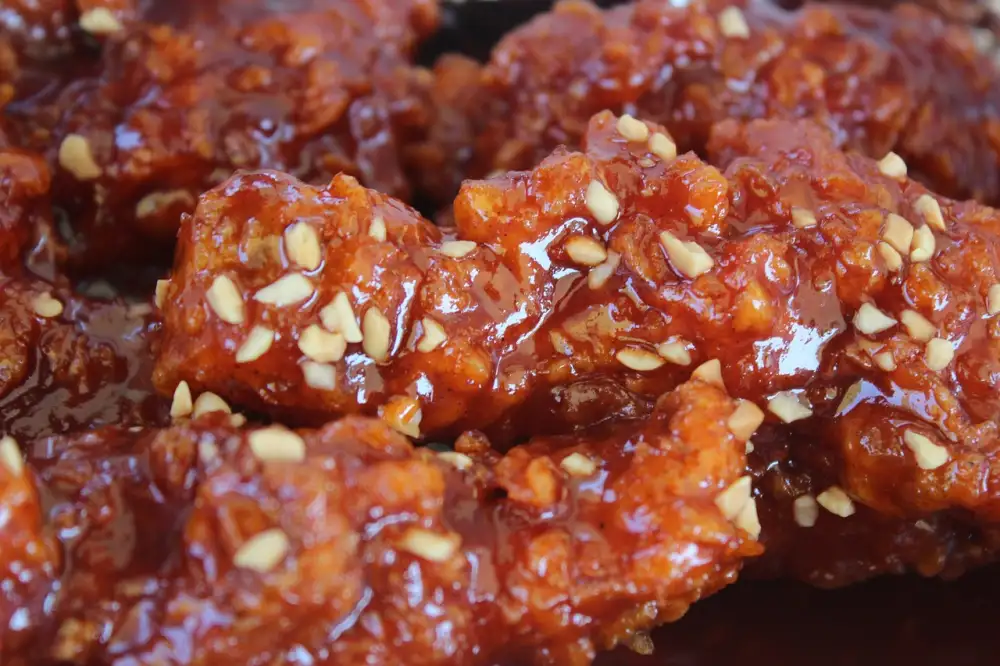Korean Chicken Delight: Unveiling the Savory Flavors of this Irresistible Dish

- History and Origins of Korean Chicken
- Key Ingredients used in Korean Chicken
- Popular Variations of Korean Chicken
- Traditional Cooking Methods for Korean Chicken
- Tips for Making Delicious Korean Chicken at Home
- Serving Suggestions and Accompaniments for Korean Chicken
- Health Benefits of Korean Chicken
Korean Chicken, also known as Dak-galbi, is a mouthwatering dish that has gained popularity worldwide for its unique and tantalizing flavors. This delectable dish combines tender chicken pieces with a perfect balance of sweet, spicy, and savory flavors. Whether you are a fan of spicy food or prefer milder options, Korean Chicken offers something for everyone. With its rich history and diverse variations, this dish is sure to delight your taste buds and leave you craving for more. So let's dive into the world of Korean Chicken and uncover the secrets behind its irresistible appeal.
History and Origins of Korean Chicken
Korean chicken, also known as dak-galbi, has a rich history that dates back centuries. It is believed to have originated in the city of Chuncheon, located in the Gangwon province of South Korea. The dish was initially created as a way to utilize leftover chicken and vegetables.
During the Korean War in the 1950s, food scarcity led Koreans to become resourceful with their ingredients. This led to the development of various dishes using chicken, including dak-galbi. Over time, it gained popularity and became a beloved staple in Korean cuisine.
The unique flavors and cooking techniques used in Korean chicken can be attributed to its historical roots. Traditional methods involve marinating the chicken in a spicy sauce made from gochujang (fermented chili paste), soy sauce, garlic, ginger, and other seasonings.
Today, Korean chicken has evolved into various regional variations and has even influenced international cuisine. Its popularity has spread globally due to its bold flavors and mouthwatering appeal. Whether enjoyed as a street food snack or served at traditional Korean restaurants, this dish continues to captivate taste buds around the world.
Key Ingredients used in Korean Chicken
Korean chicken is known for its bold and flavorful taste, which is achieved through the use of various key ingredients. The most essential ingredient in Korean chicken is gochujang, a spicy fermented chili paste that adds heat and depth to the dish. Soy sauce and garlic are also commonly used to enhance the savory flavors.
Another important ingredient is sesame oil, which gives a distinct nutty aroma to the chicken. Ginger is often added for its warming and aromatic qualities. To balance out the spiciness, sugar or honey is used to add a touch of sweetness.
In addition to these main ingredients, Korean chicken may also include other seasonings such as rice wine vinegar, black pepper, and green onions. These ingredients work together to create a harmonious blend of flavors that make Korean chicken so irresistible.
By using these key ingredients in the right proportions, you can recreate the authentic taste of Korean chicken at home. Experimenting with different combinations and adjusting the spice level according to your preference will allow you to personalize this delightful dish while still honoring its traditional roots.
Popular Variations of Korean Chicken
Korean cuisine is known for its diverse flavors and unique cooking techniques, and Korean chicken is no exception. This delectable dish has gained immense popularity not only in Korea but also around the world. Here are some popular variations of Korean chicken that you must try:
1. Yangnyeom Chicken: This is perhaps the most well-known variation of Korean chicken. It features crispy fried chicken coated in a sticky, spicy-sweet sauce made with gochujang (Korean red chili paste), soy sauce, garlic, ginger, and honey. The combination of heat and sweetness makes it incredibly addictive.
2. Ganjang Chicken: Unlike yangnyeom chicken, ganjang chicken is marinated in a savory soy sauce mixture before being fried to perfection. The marinade typically includes soy sauce, garlic, ginger, sesame oil, and sugar. The result is tender and flavorful chicken with a rich umami taste.
3. Dakgangjeong: Dakgangjeong is a popular street food in Korea that consists of bite-sized boneless chicken pieces coated in a crunchy batter and deep-fried until golden brown. It is then tossed in a sweet and sticky glaze made with soy sauce, honey, garlic, and ginger. The contrast between the crispy exterior and tender interior makes it irresistible.
4. Oven-baked Chicken: For those who prefer a healthier option without compromising on flavor, oven-baked Korean chicken is an excellent choice. The chicken pieces are marinated in a flavorful sauce similar to yangnyeom or ganjang chicken and then baked until juicy and golden brown.
These are just a few examples of the many variations of Korean chicken available. Each variation offers its own unique blend of flavors that will tantalize your taste buds and leave you craving for more.
Whether you prefer spicy or savory flavors, there's a Korean chicken dish out there that will suit your palate. So, don't hesitate to explore the diverse world of Korean chicken and discover your favorite variation.
Traditional Cooking Methods for Korean Chicken
Korean chicken is known for its unique cooking methods that result in tender and flavorful meat. One popular technique is called "yangnyeom," which involves marinating the chicken in a mixture of soy sauce, garlic, ginger, and other spices before grilling or frying it to perfection.
Another traditional method is "tongdak," where the chicken is deep-fried twice to achieve a crispy exterior while keeping the inside juicy. This method creates a delightful contrast of textures that is loved by many.
One more cooking method worth mentioning is "samgyetang," which involves stuffing a whole chicken with glutinous rice, ginseng, jujubes, and garlic. The stuffed chicken is then simmered in a rich broth until the flavors meld together beautifully.
These traditional cooking methods not only enhance the taste but also create visually appealing dishes that are sure to impress. Whether you prefer grilled, fried, or simmered Korean chicken, each method brings out the best flavors and textures of this beloved dish.
Tips for Making Delicious Korean Chicken at Home
1. Marinating is Key: To infuse the chicken with flavor, marinate it for at least 2 hours or overnight. Use a mixture of soy sauce, garlic, ginger, and other spices to create a rich and savory marinade.
2. Double Fry for Extra Crispy Texture: Achieve that irresistible crunch by double frying the chicken. After the first fry, let it rest for a few minutes before frying it again until golden brown and crispy.
3. Use Cornstarch for a Lighter Coating: For a lighter coating that still gives you that satisfying crunch, mix cornstarch with flour before dredging the chicken. This will result in a crispier texture without being too heavy.
4. Experiment with Spices: Don't be afraid to play around with different spices and seasonings to customize your Korean chicken. Add chili flakes for some heat or sesame seeds for extra nuttiness.
5. Baking Option: If you prefer a healthier alternative to frying, try baking the marinated chicken in the oven instead. This method will still give you tender and flavorful results without the added oil.
6. Garnish with Green Onions and Sesame Seeds: Before serving, sprinkle chopped green onions and toasted sesame seeds over your Korean chicken dish. These garnishes not only add visual appeal but also enhance the overall taste.
By following these tips, you can recreate the delicious flavors of Korean chicken right in your own kitchen. Enjoy this mouthwatering dish with family and friends!
Serving Suggestions and Accompaniments for Korean Chicken
Korean chicken is a versatile dish that can be enjoyed in various ways. It pairs well with steamed rice, which helps to balance out the bold flavors. For a complete meal, consider serving it with a side of kimchi, a traditional Korean fermented vegetable dish that adds a tangy and spicy kick.
Another popular accompaniment is pickled radish, known as "danmuji," which provides a refreshing contrast to the rich flavors of the chicken. You can also serve it with lettuce leaves or cabbage wraps, allowing you to create your own delicious Korean chicken wraps.
To enhance the overall experience, consider garnishing your dish with sesame seeds and finely chopped green onions. These add an extra layer of flavor and visual appeal. Additionally, you can drizzle some spicy gochujang sauce on top for those who enjoy an extra kick of heat.
For those looking to add more variety to their meal, consider serving Korean chicken alongside other traditional Korean dishes such as bibimbap (a mixed rice dish), japchae (stir-fried glass noodles), or banchan (a selection of small side dishes).
No matter how you choose to serve it, Korean chicken is sure to delight your taste buds and leave you craving for more. So go ahead and explore the endless possibilities of this irresistible dish!
Health Benefits of Korean Chicken
Korean chicken not only tantalizes our taste buds but also offers numerous health benefits. Firstly, it is a great source of lean protein, which helps in building and repairing tissues and muscles. This makes it an excellent choice for those looking to maintain or build muscle mass.
Additionally, Korean chicken is often marinated with various spices and ingredients that are known for their medicinal properties. Garlic, ginger, and chili peppers are commonly used in the marinade, all of which have anti-inflammatory and immune-boosting properties.
Furthermore, Korean chicken is typically cooked using healthier methods such as grilling or baking instead of deep-frying. This reduces the amount of unhealthy fats consumed while still retaining its delicious flavors.
Moreover, the dish often includes vegetables like carrots, onions, and bell peppers, providing essential vitamins, minerals, and dietary fiber. These vegetables contribute to better digestion and overall gut health.
Lastly, Korean chicken can be customized to suit different dietary preferences. It can be made gluten-free by using alternative flours or sauces and can also be made healthier by reducing the amount of sugar or sodium used in the marinade.
In conclusion, indulging in Korean chicken not only satisfies our cravings but also provides us with a range of health benefits. From being a good source of protein to offering anti-inflammatory properties and promoting digestive health, this dish truly deserves its place on our plates.
In conclusion, Korean chicken is a dish that truly captivates the taste buds with its unique blend of flavors. Whether you prefer the spicy and tangy flavors of yangnyeom chicken or the sweet and savory taste of dakgangjeong, there is a variation for everyone to enjoy.
The history and origins of Korean chicken add a cultural richness to this delightful dish, making it not just a meal but an experience. The key ingredients used in Korean chicken, such as gochujang and soy sauce, contribute to its distinct flavor profile.
Traditional cooking methods like frying and grilling ensure that the chicken remains tender on the inside while achieving a crispy exterior. By following some simple tips, you can recreate these mouthwatering flavors in your own kitchen.
When serving Korean chicken, consider pairing it with traditional accompaniments like pickled radish or kimchi for a complete dining experience. These side dishes complement the flavors of the chicken and add an extra layer of texture.
Not only does Korean chicken satisfy your taste buds, but it also offers several health benefits. Chicken is a lean source of protein that supports muscle growth and repair. Additionally, many variations of Korean chicken incorporate nutritious ingredients like garlic, ginger, and vegetables.
So why not embrace the flavors of Korean chicken? Whether you're enjoying it at a restaurant or preparing it at home, this dish promises to take your palate on an unforgettable journey through Korea's culinary wonders.
Published: 20. 11. 2023
Category: Food



